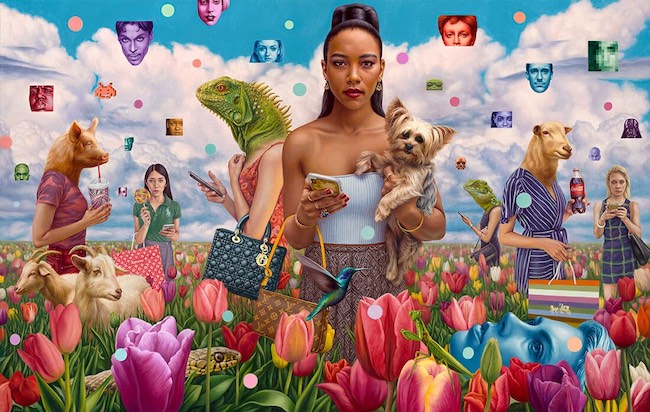Analizzare e osservare il vivere contemporaneo costituisce il principale spunto di partenza per l’elaborazione del linguaggio artistico attraverso cui i creativi narrano il proprio punto di vista, i concetti, le elaborazioni che seguono alla contemplazione della realtà. Malgrado questo forte legame con l’oggettività, vi sono però alcuni autori che avvertono la necessità di sottolineare tutto ciò che di assurdo e di illogicamente incongruente emerge nel mondo moderno, sviluppando uno stile che permette all’osservatore di avvicinarsi all’opera attratto da qualcosa che il suo sguardo conosce, per poi trovarsi immerso in una visione parallela in cui l’irrealtà si unisce a un’analisi fortemente critica di tutto ciò che costituisce il vivere attuale. L’artista di cui vi racconterò oggi mette in evidenza i vizi e le manie della società contemporanea attraverso una cifra pittorica fortemente reale attraverso la quale indaga tutto ciò che non viene visto, ma che di fatto esiste, comprese possibilità impensate con un significato profondo tutto da scoprire.
Quando nei primi decenni del Novecento cominciarono a delinearsi nuovi approcci artistici che da un lato intendevano superare le regole accademiche precedenti e dall’altro dovevano essere affini all’evolversi della società, all’inedito punto di vista su tutto ciò che apparteneva alla realtà dell’epoca ma anche ai rapidi cambiamenti che si stavano verificando nell’intera Europa, emerse un movimento che mantenne il forte legame con la figurazione di tipo tradizionale ma al tempo stesso introduceva il concetto di esplorazione della mente, dei disagi piscologici che si svelavano nella fase onirica sotto forma di incubi, e di quel subconscio che nello stato di veglia veniva messo in silenzio. Il Surrealismo, questo il nome della corrente, si impose di mettere in luce tutte le angosce ma anche le ossessioni dell’uomo degli inizi del Ventesimo secolo, le pulsioni carnali così come quelle nei confronti dello scorrere del tempo, le paure nei confronti della vita e della morte, tratteggiando mondi paralleli privi di un senso immediatamente intuibile eppure in grado di indurre una profonda riflessione su tutto ciò che esiste al di sotto del visibile. Le irrealtà di Salvador Dalì si affiancavano dunque agli scenari post-apocalittici di Yves Tanguy e Max Ernst, tutti ispirati dal lavoro di ricerca psicologica di Sigmund Freud, così come alle atmosfere estranianti e meditative di René Magritte dove la visione diveniva interpretazione di pulsioni e riflessione sulle energie sottili che avvolgono la realtà. Dopo molti decenni da quel periodo, e dopo un passaggio significativo verso un’arte meno intellettuale e più popolare che si concretizzò con la Pop Art, emerse negli Stati Uniti uno stile che coniugò le esplorazioni irreali del Surrealismo ai simboli popolari vicini al mondo dei fumetti e della musica punk rock, rinnovando l’interesse verso quelle atmosfere improbabili e paradossali che però andavano a concretizzarsi con personaggi sinistri, ambientazioni noir, o ancora immortalando personaggi delle fiabe gotiche. Il movimento prese così il nome di Lowbrow, o più comunemente Pop Surrealismo, che ebbe in Mark Ryden uno dei maggiori esponenti, autore di opere inquietanti e volte a lasciar emergere opzioni alle quali la mente non è abituata, suscitando pertanto una prima reazione di rifiuto che però in un secondo momento tende a spingersi a comprendere il senso più profondo. L’artista contemporaneo statunitense Alex Gross interpreta il Pop Surrealismo in maniera diversa, meno lugubre e più concentrata sul sociale, su tutto ciò che appartiene al vivere attuale non senza inserire però la componente bizzarra, la realtà parallela che tutto enfatizza e attraverso cui svela le sue riflessioni su molti aspetti della quotidianità estremizzati nelle sue tele.
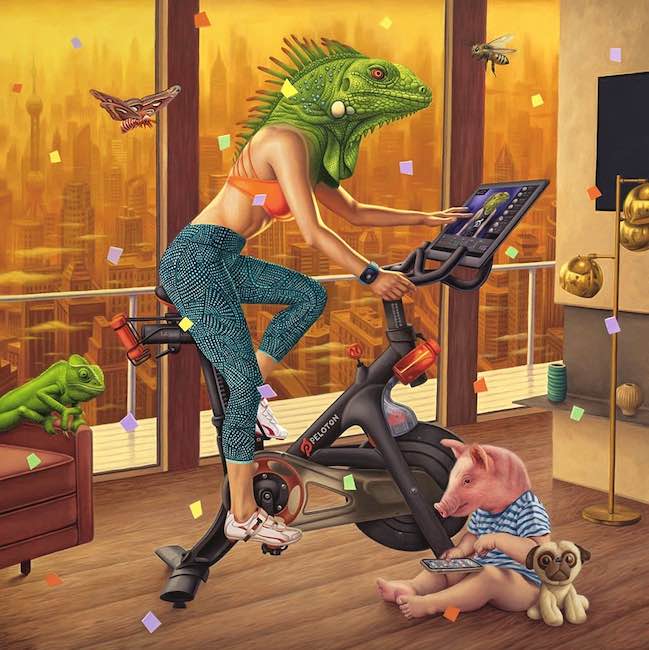
Lo stile parte dall’Iperrealismo per quanto riguarda il tratto pittorico, ma poi si sposta su un livello diverso, assurdo, paradossale e dunque tendente inevitabilmente al Surrealismo; tuttavia la presenza dei temi popolari, come i marchi di moda, i personaggi dei fumetti della Marvel nelle loro trasposizioni cinematografiche, il forte legame con la tecnologia e i social network, lo fanno entrare di diritto nel Pop Surrealismo. La ricerca che compie Alex Gross nel mettere in luce gli aspetti del vivere contemporaneo, è diretta al fenomeno del condizionamento di massa, quell’inclinazione dell’essere umano di oggi a voler avere e fare ciò che fanno e hanno gli altri per non sentirsi escluso dalla direzione verso cui tutti si muovono.
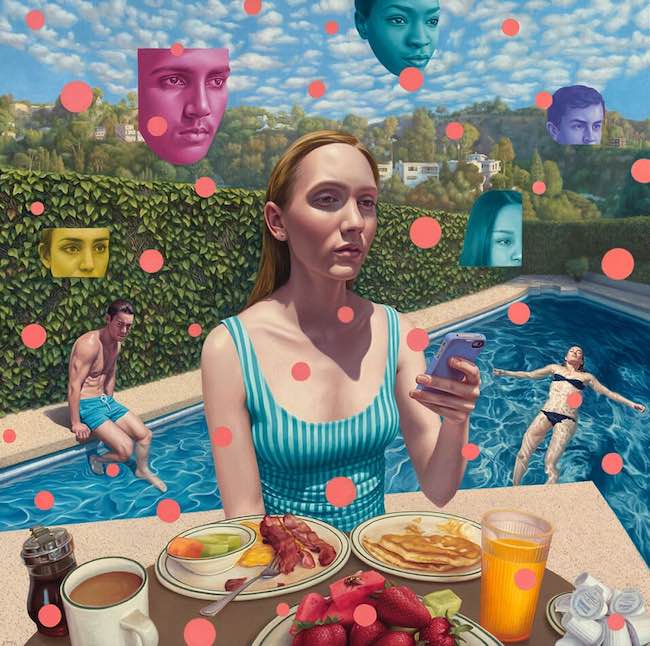
La gamma cromatica che preferisce è chiara, vivace, quasi a voler attrarre l’osservatore con il fascino di colori che non sembrano condurre a un approfondimento come quello che invece contraddistingue l’artista, così lo sguardo viene attratto da quella vitalità e da quei simboli noti, da quei volti che fanno parte dell’immaginario comune, ma poi compie un naturale sforzo di approfondimento andando a indagare sulle implicazioni, sul senso degli oggetti o del coinvolgimento dei personaggi all’interno di un mondo che sembra essere completamente omologato, malgrado le apparenti differenze.
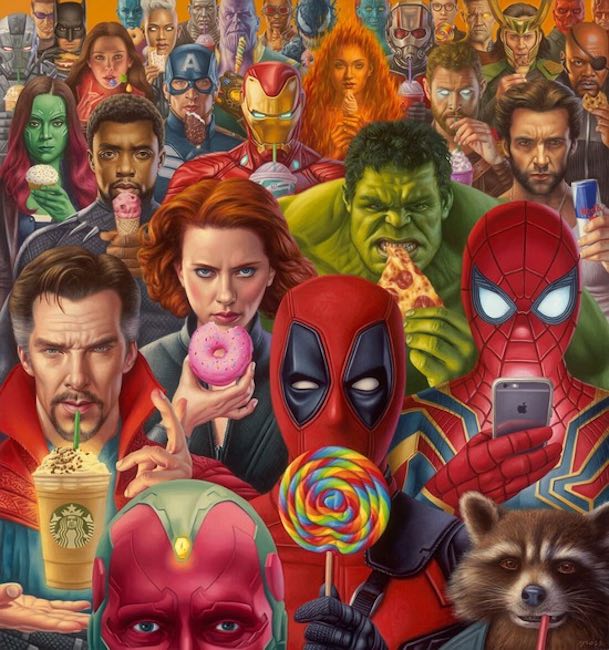
Nella tela Diversions Alex Gross immortala infatti tutti gli interpreti cinematografici degli eroi Marvel ciascuno con un simbolo gastronomico appartenente alla cultura americana, inducendo l’osservatore a credere che quei celeberrimi personaggi ne siano sponsor, per poi un attimo dopo domandarsi se di fatto loro, come l’uomo contemporaneo, non se siano invece schiavi. Le mode, sussurrate regole della società senza le quali le persone sembrano essere tagliate fuori, sono qualcosa di talmente insito nell’evoluzioni dei tempi fin dall’avvento del consumismo, dunque dagli anni Cinquanta del Novecento, che ormai sembra essere divenuto impossibile uscire da quelle leggi implicite a meno di non avere abbastanza coraggio da essere in grado di uscire fuori dal coro conoscendo il rischio di rimanere isolati, messi da parte da un mondo che tende a non accettare l’individualismo.

A sottolineare quanto il messaggio di Gross sia orientato invece a suggerire alle persone di aprire gli occhi e uscire dal meccanismo di condizionamento, la tela Shopaholics appare fortemente critica nei confronti di chi si omologa, di chi si lascia sottoporre a quella costante esortazione all’acquisto indotta dai media e dalla pubblicità; i due personaggi infatti hanno delle teste di pecore, dunque sottolineando un forte biasimo da parte dell’artista nei confronti di tutte le persone che si lasciano andare al consumismo compulsivo, a quell’esigenza di possedere per nascondere l’incapacità o la paura di essere, riducendosi così a involucri vuoti a cui dare una splendida apparenza per colmare la carenza di sostanza.

Nell’opera Twins, Alex Gross mescola ed enfatizza il suo sguardo su un’umanità che più che vivere sembra intenta a sopravvivere, andando in maniera inconsapevole verso la medesima direzione, come se non vi fosse alternativa, e persino le due gemelle in primo piano, che scelgono di salire su una Vespa, invece che camminare come tutti gli altri, non riescono a percepire la gioia, l’entusiasmo, mostrano l’estraniamento tipico di chi ha perso il senso del tutto, o di chi non è più in grado di interrelazionarsi con l’essere umano reale perché troppo distratto dai rapporti fittizi dei social network che illudono di essere popolari e pieni di amicizie ma dall’altro lasciano inevitabilmente soli e incapaci di guardare le persone negli occhi. Le immagini virtuali dunque appaiono compagnia irrinunciabile della moltitudine, vera protagonista della tela, che non si trova in nessun luogo in particolare perché l’ambientazione è affine al modo di vivere di tutti i luoghi, o forse perché l’intera società contemporanea è completamente uniformata e dunque non più individuabile nel luogo e nella cultura. I cellulari sono simbolo di questa omologazione, come se senza di essi l’individuo non fosse più in grado di trovare un senso alla vita.
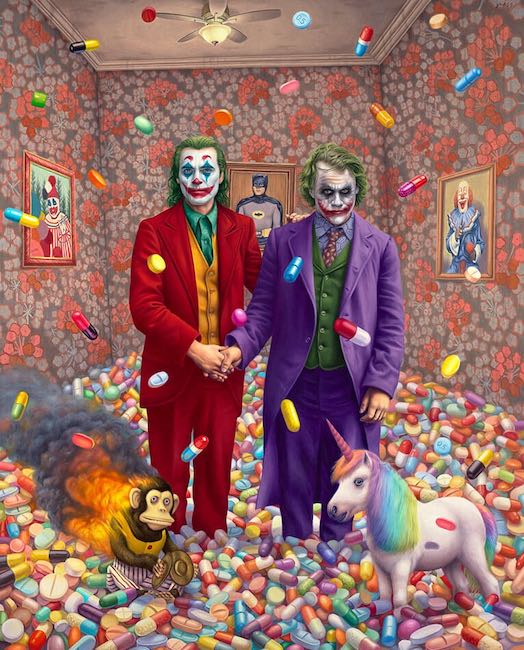
Gli schemi e le manie che sfociano in psicosi sono protagonisti anche dell’opera Prisons of the mind dove i due attori che hanno interpretato la controversa e inquietante figura di Jocker, antagonista di Batman, costituiscono il simbolo di un malessere interiore, di una piaga sociale, quella dei disagi psicologici, che vengono curati con gli psicofarmaci i quali a loro volta generano un meccanismo di causa ed effetto da cui è difficile uscire. La cura diviene perciò la malattia, esattamente come in Jocker la cui follia causata da un rifiuto sociale, lo conduce a divenire un pericoloso criminale per sottrarsi al rifiuto vendicandosi sulla società.
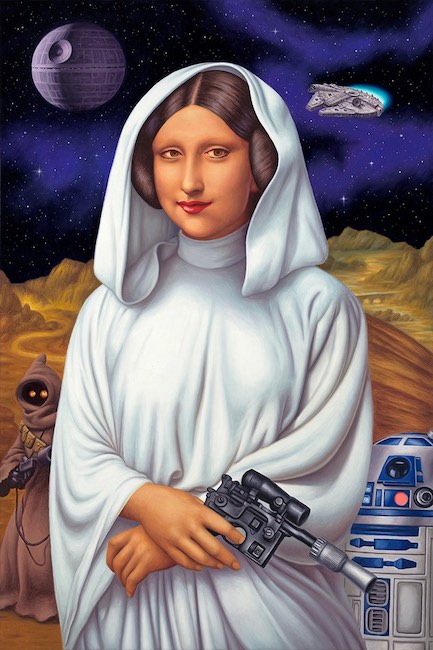
Alex Gross ha al suo attivo numerose mostre personali in gallerie e musei negli Stati Uniti e in tutto il mondo e le sue opere fanno parte di collezioni private in Turchia, Cina, Spagna e Nuova Zelanda.
ALEX GROSS-CONTATTI
Email: studio@alexgross.com
Sito web: https://www.alexgross.com/
Facebook: https://www.facebook.com/artofalexgross
Instragram: https://www.instagram.com/artofalexgross/
The paradoxes of Alex Gross, between movie comics and contemporary obsessions underlining the attitude of 21st century man towards homologation
Analysing and observing contemporary life constitutes the main starting point for the elaboration of the artistic language through which creatives narrate their point of view, concepts and elaborations that follow the contemplation of reality. In spite of this strong link with objectivity, there are, however, some authors who feel the need to emphasise all that is absurd and illogically incongruent that emerges in the modern world, developing a style that allows the observer to approach the artwork attracted by something that his gaze knows, only to find himself immersed in a parallel vision in which unreality is united with a strongly critical analysis of everything that constitutes current living. The artist I am going to tell you about today highlights the vices and foibles of contemporary society with a strongly real pictorial style through which he investigates everything that is unseen, but which in fact exists, including unthought-of possibilities with a profound meaning yet to be discovered.
When new artistic approaches began to emerge in the first decades of the 20th century, which on the one hand intended to go beyond the previous academic rules and on the other hand had to be akin to the evolution of society, to the unprecedented viewpoint of everything that belonged to the reality of the time, but also to the rapid changes that were taking place in the whole of Europe, there emerged a movement that maintained strong ties with traditional figuration but at the same time introduced the concept of exploration of the mind, of the piscological discomforts that were revealed in the dream phase in the form of nightmares, and of that subconscious that was silenced in the waking state. Surrealism, this is the name of the current, set out to highlight all the anxieties but also the obsessions of early 20th century man, carnal urges as well as those towards the passing of time, fears for life and death, sketching parallel worlds with no immediately intuitable meaning yet capable of inducing profound reflection on all that exists below the visible. Salvador Dali‘s unrealities were thus juxtaposed with the post-apocalyptic scenarios of Yves Tanguy and Max Ernst, all inspired by Sigmund Freud‘s psychological research work, as well as the alienating and meditative atmospheres of René Magritte where vision became an interpretation of drives and a reflection on the subtle energies that envelop reality. Many decades later, and after a significant shift towards a less intellectual and more popular art that took the form of Pop Art, a style emerged in the United States that combined the unreal explorations of Surrealism with popular symbols close to the world of comic strips and punk rock music, renewing interest in those improbable and paradoxical atmospheres that took the form of sinister characters, noir settings, or even immortalising characters from Gothic fairy tales.
The movement thus took the name of Lowbrow, or more commonly Pop Surrealism, which had in Mark Ryden one of its major exponents, the author of disturbing artworks aimed at allowing options to emerge to which the mind is not accustomed, thus provoking an initial reaction of rejection that however later tends to go as far as understanding the deeper meaning. The contemporary American artist Alex Gross interprets Pop Surrealism in a different way, less lugubrious and more focused on the social, on everything that belongs to present-day living, not without however inserting the bizarre component, the parallel reality that emphasises everything and through which he reveals his reflections on many aspects of everyday life that are taken to extremes in his canvases. The style starts from Hyperrealism as far as the pictorial stroke is concerned, but then moves to a different level, absurd, paradoxical and therefore inevitably tending towards Surrealism; however, the presence of popular themes, such as fashion brands, Marvel comic book characters in their cinematographic transpositions, the strong link with technology and social networks, make it rightfully part of Pop Surrealism. Alex Gross‘s research in highlighting aspects of contemporary living is directed at the phenomenon of mass conditioning, that inclination of today’s human being to want to have and do what others do and have so as not to feel excluded from the direction in which everyone is moving. The chromatic range he prefers is clear, lively, almost as if he wanted to attract the observer with the charm of colours that do not seem to lead to the kind of in-depth analysis that characterises the artist, so that the gaze is attracted by that vitality and by those well-known symbols, by those faces that are part of the common imagination, but then makes a natural effort to investigate the implications, the meaning of the objects or the involvement of the characters within a world that seems to be completely homologated, despite the apparent differences.
In the canvas Diversions Alex Gross in fact immortalises all the cinematic performers of Marvel heroes each with a gastronomic symbol belonging to American culture, leading the observer to believe that those celebrated characters are sponsors, only to wonder a moment later whether they, like contemporary man, are not instead slaves. Fashions, the whispered rules of society without which people seem to be cut off, are something so inherent in the evolution of the times since the advent of consumerism, i.e. since the 1950s, that it now seems to have become impossible to break out of those implicit laws unless one is brave enough to be able to step out of the chorus, knowing the risk of being isolated, sidelined by a world that tends not to accept individualism. Underlining the extent to which Gross‘s message is aimed instead at suggesting that people open their eyes and break out of the conditioning mechanism, the canvas Shopaholics appears highly critical of those who conform, of those who allow themselves to be subjected to the constant exhortation to buy induced by the media and advertising; ttwo characters in fact have sheep’s heads, thus emphasising the artist’s strong disapproval of all people who indulge in compulsive consumerism, in that need to possess in order to hide their inability or fear of being, thus reducing themselves to empty shells to which they give a splendid appearance in order to make up for the lack of substance.
In Twins, Alex Gross mixes and emphasises his view of a humanity that rather than living seems intent on surviving, unconsciously going in the same direction, as if there were no alternative, and even the twins in the foreground, who choose to get on a Vespa instead of walking like everyone else, fail to perceive joy, enthusiasm, they show the estrangement typical of those who have lost the sense of it all, or of those who are no longer able to interrelate with real human beings because they are too distracted by the fictitious relationships of social networks that delude one into thinking they are popular and full of friendships but on the other hand inevitably leave one lonely and unable to look people in the eye. The virtual images therefore appear to be the indispensable companion of the multitude, the true protagonist of the canvas, which is not to be found in any particular place because the setting is akin to the way of life of all places, or perhaps because the whole of contemporary society is completely standardised and therefore no longer identifiable in place and culture. Mobile phones are a symbol of this standardisation, as if without them the individual is no longer able to find meaning in life. The schemes and manias that lead to psychosis are also the protagonists of the work Prisons of the mind where the two actors who played the controversial and disturbing figure of Jocker, Batman’s antagonist, are the symbol of an inner malaise, of a social plague, that of psychological discomfort cured with psychotropic drugs which in turn generate a cause and effect mechanism from which it is difficult to escape. The cure therefore becomes the disease, just as in Jocker whose madness caused by social rejection leads him to become a dangerous criminal in order to escape rejection by taking revenge on society. Alex Gross has numerous solo exhibitions in galleries and museums in the United States and around the world, and his paintings are part of private collections in Turkey, China, Spain and New Zealand.


